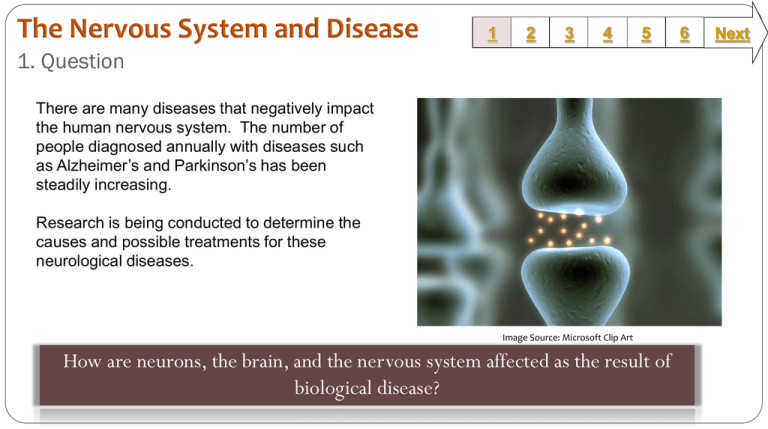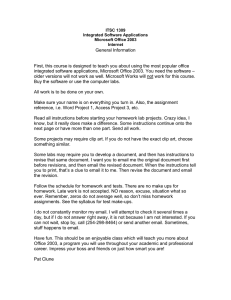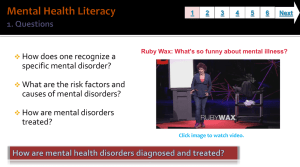
1
2
3
4
5
1. Question
There are many diseases that negatively impact
the human nervous system. The number of
people diagnosed annually with diseases such
as Alzheimer’s and Parkinson’s has been
steadily increasing.
Research is being conducted to determine the
causes and possible treatments for these
neurological diseases.
Image Source: Microsoft Clip Art
How are neurons, the brain, and the nervous system affected as the result of
biological disease?
6
Next
2. Information Sources
1
2
3
4
5
Huntington's disease
Parkinson’s Disease
Disease Overview
Disease Overview
Background and Diagnosis
Dr. Oz Discusses
NHS Video and Article
Parkinson’s Disease Foundation Stanford University Project
ALS (Lou Gehrig's disease)
Alzheimer's Disease
Disease Overview
Statistics/Global Concern
PBS Overview
Brain Pop Video
Stephen Hawking Lives with
Treatment
ALS
NY Times Article
ALS Association
National Geographic Diagram
Multiple Sclerosis
Disease Overview
Dr. Murray Interview
Brain Pop Video
NY Times Article
Image Source: Microsoft Clip Art
6
Next
3. Student Activity
1
2
3
4
5
As you use the informational resources provided take
notes on your neurological disease. Make sure that
your research analyzes each of the neurological levels
that are negatively effect by the disease.
Inquiry
Organizer
Image Source: Microsoft Clip Art
6
Next
4. Assessment Activity
1
2
3
4
Develop a group presentation that
summarizes your findings, organize your
group presentation using a digital platform
such as PowerPoint, Prezi, Thinglink ,
Inspiration, Animoto or Padlet.
Present your findings to the class and take
Cornell Notes
Record details and examples to clarify your
understanding of each neurological disease
and think about how it compares to your
research.
Image Source: Microsoft Clip Art
5
6
Next
1
5. Enrichment Activities
2
3
4
5
6
Next
Research one structure of the brain utilizing the resources below.
After conducting your research on a specific brain structure you will
create an infographic that…
1) Analyzes the functions of the brain structure
2) How this structure works with other parts of the brain
3) Discusses any disorders that are associated with your chosen
structure.
National Geographic
Brain Basics
The Human Brain
To create your infographic you can use one of the following digital
platforms.
Piktochart
infogr.am
Image Source: http://newsroom.ucla.edu/portal/ucla/srp-view.aspx?id=152450
6. Teacher Support Materials
1
2
3
4
5
6
BCPS Curriculum
Time Frame:
Unit 1: Indicator 03. Students will investigate the components of the nervous system in order to
determine neurological functions.
This lesson should take one 90 minute period or two 45
minute class periods to conduct research and create
student presentation.
Common Core State Standards
Reading: 1. Read closely to determine what the text says explicitly and to make logical inferences
from it; cite specific textual evidence when writing or speaking to support conclusions drawn from
the text.
Writing: 7. Conduct short as well as more sustained research projects based on focused questions,
demonstrating understanding of the subject under investigation.
21st
Standards for the
Century Learner
1.1.6 Read, view, and listen for information presented in any format (e.g. textual, visual, media,
digital) in order to make inferences and gather meaning.
2.1.3 Use strategies to draw conclusions from information and apply knowledge to curricular
areas, real-world situations, and further investigations.
Maryland Technology Literacy Standards for Students
3.0: Use a variety of technologies for learning and collaboration.
Differentiation:
Direct students to use comprehension tools included in
databases, such as: audio read-aloud, labeled reading levels, and
embedded dictionaries.
Learning Styles:
Visual, auditory, field dependent, global
AVID Strategy: Cornell Notes
Notes to the teacher:
Teachers should choose/ approve what groups and disease students
will analyze.
Teachers will need to see their technology liaison or library media
specialist for assistance in creating accounts for Wall Wisher, Voice
Thread , Prezi, Glogster or Animoto accounts. All of these do not
require a fee but must have access before students begin this project.
Last updated: July 2015
Created by Sarah McComb linked to email address, Social Studies Teacher
BCPS Slam Dunk Research Model, Copyright 2013, Baltimore County Public Schools, MD, all rights reserved. The models may be used for educational, non-profit school use only.
All other uses, transmissions, and duplications are prohibited unless permission is granted expressly. This lesson is based on Jamie McKenzie’s Slam Dunk Lesson module.


